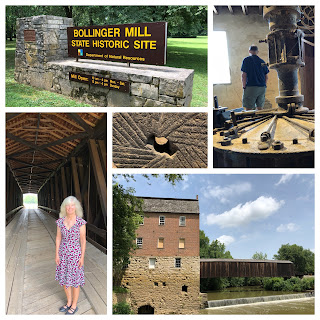During our visit to the Mississippi River Museum in Memphis, Tim and I just happened to pick up a map of The Great River Road, a National Scenic Byway that runs parallel on both sides of the Mississippi River all the way from its headwaters in Minnesota to its mouth at the Gulf of Mexico. Since we are headed north to Minneapolis for a vacation with our children in mid-July, I decided we should forsake the interstates and travel the back roads there instead. Low and behold, Tim agreed!
Green paddlewheel highway markers tell you that you're on the right track, but I also went online to The Great River Road web site. There I discovered possible itineraries and information about roadside attractions that helped me plan our trip. Being a Kansas farm girl, I'm always intrigued by places that promote agriculture so I found the section on Agritourism most helpful. There you select a category you wish to visit such as B & Bs, cheese factories, pick-your-own orchards, farm petting zoos or wineries. Of course, the page also lists museums and interpretive centers as well.
I also downloaded The Great River Road app to my cell phone, but I wouldn't recommend it. Every time I tried to access location information for a specific attraction, the app crashed when I tried to return to the map. Very frustrating! Stick to your laptop or iPad instead.
On Day One, we drove north on The Great River Road which was actually Highway 61 on the Arkansas side of the river. First, we stopped in Wilson, Arkansas to visit the Hampson Archeological Museum, but we found its door shuttered. Oh, boy! Will this hitch cause Tim to override my plans and return to the interstate? Sheesh! We've only started!
But thankfully, he humored me and our next stop revealed a true gem: Ms. Glynda Thompson, President of the Mississippi County Historical & Genealogical Society.
 |
| Ms. Glynda |
 |
| The City of Osceola steamship |
Regarding her own small town of Osceola, Ms. Thompson was proud to tell us how the community grew up around the Plum Point steamboat river landing, the departure point for shipping area cotton downriver to Memphis. Another jewel was her story of the Civil War's Battle of Plum Point Bend, a seeming David versus Goliath clash from which the Confederates emerged victorious. A squadron of Union ironclads had tied up for the night when in the early morning hours of May 10, 1862, the Confederate River Defense Fleet, a motley party of wooden sidewheel paddleboats converted to naval rams, chanced upon them and fired. The USS Cincinnati and the USS Mound, both ironclad river gunboats, were so badly damaged that they sank along the river banks.
 |
| The Mississippi's horseshoe bend at New Madrid |
Bidding Ms. Glynda goodbye, we continued up The Great River Road to New Madrid, MO, situated at the north end of a horseshoe bend in the Mississippi.
The museum in New Madrid (which by the way is pronounced "MAD-drid" not "muh-DRID" like the city in Spain) tells how the 400 residents of the town were jolted awake on December 16, 1811 by a powerful earthquake. That winter--in the span of just three months--four more major quakes and thousands of aftershocks would rock the land. During one quake, the land on the east side of the river sank 10 feet.
People said the Mississippi River ran backward--perhaps an exaggeration, but certainly new sections of river channel were formed and old channels cut off. Since 1974, instruments that continually measure seismic activity in the area have recorded more than 4,000 earthquakes. Most are quite mild; in fact, people can't even feel them, but even so this is an area to closely watch.
Then on to Cape Girardeau, MO, where we had Airbnb reservations for a private room in the home of Brinda and Omer. They were such wonderful hosts that we extended our stay there two more nights.
We needed those extra days to do justice to the three places they told us we should visit. When we asked if there was a good hiking trail, they told us of the nearby Trail of Tears State Park where nine of the thirteen Cherokee Indian groups being relocated to Oklahoma crossed the Mississippi River during the harsh winters of 1838 and 1839.
They also suggested we visit the quaint French colonial village of St. Genevieve, MO and a few of the wineries on its Route du Vin which we did and yes, they were very good.
Finally, we squeezed in a stop at the Bollinger Mill Historic Site on our way back from church.
So, there you have it! Day One with another two days for rest thrown in and we were 186 miles north of Memphis and all the richer for taking the roads less traveled.










Glad to hear you are still channeling your inner farm girl! Wishing you safe journeys on the road(s) less traveled!
ReplyDelete